183
Views & Citations10
Likes & Shares
The empowerment of Scheduled Castes (SC) and Scheduled Tribes (ST) through participation in local self-government has emerged as an important phase of the ongoing socio-economic and political transformation process in India. The seventy third Constitutional Amendment is a milestone in empowerment of women belonging to weaker sections. This enabled reservation of 33 per cent of the Gram Panchayat seats for women. Recently, government of Karnataka has increased the reservation from 33 per cent to 50 per cent for women. Large numbers of women belonging to weaker sections (SC & ST) entered Gram Panchayats for the first time, due to reservation. Efforts have been made to empower members, especially the women representatives of Gram Panchayat (GP) through different types of training programme to increase their participation, level of understanding and create awareness. In this context, the paper tries to understand the process and level of empowerment of female GP members belonging to weaker sections, based on personal interview of 53 GP women members of Hubballi taluk in Karnataka. The paper presents socio-economic profile of SC/ST women representatives, usefulness of reservation of seats for women, motivating factors for contesting the election, decision making power, participation in local organizations, and willingness to contest the future election for Panchayat bodies. Moreover, the usefulness of special capacity building programme conducted by Centre for Multi-disciplinary Development Research (CMDR) has also been presented.
The 73rdAmendment to the Constitution brought in 1992 is a major breakthrough that assures participation of disadvantaged groups in political administration. It brought a 33 % reservation for women into the Panchayat Raj System of local governance in India. Through government legislation some of the panchayat posts have been reserved for women i.e. for SC, ST and OBC (Article 243(D) of the Constitution of India). Therefore, by advantage of reservation, members of SC/ST group have become panchayat leaders and members. Recently government of India and all states have increased the proportion of women reservation seats up to 50 %. Many of the states (including Karnataka) have raised their women reservation quota to 50 %. But unfortunately, in many cases these social exclusive representatives (SC/ST) are unaware of their duties and responsibilities. Government has tried to create awareness on duties and responsibilities of PRI representatives.
A study by DAC, (2009) in Karnataka on tribal communities and panchayats reveals that the members have very little say in decision making. This study reports that tribal community is still oppressed and not able to fully participate in the mainstream activity due to lack of empowerment of people belonging to the tribal community. Tame, (2014) in her study on tribal women in Arunachal Pradesh, reports that reservation has created space for tribal women’s needs and they are slowly gaining confidence to perceive their roles by familiarizing themselves with panchayat rules. It was also noted that there was change in their perceptions of themselves although there were a few who acted like ‘puppets’. They also seemed to be interested in politics as many of them wanted government to organize campaigns to politically empower them. Another study by Sivanna, (2014) covering Mandya and Gulbarga tries to answer whether SC members and presidents of GP are able to participate in decision making process at panchayat level. This study reveals that the involvement of SC members in decision making is limited and is confined to issues related only to SCs. Although the study finds no disinclination against SC presidents, it indicates the efforts of dominant castes to elect presidents who can be manipulated. Members reported that political parties are inevitable as each member recognizes himself or herself with political parties, which creates differences among members and sometimes leads to clashes on account of differences of opinions. The study reports that as per the perceptions of GP members, dominant castes preferred dummy candidates and their dominance was due to ignorance of SCs about rules, procedures and fear of officials. Members also felt that both education and political skills are necessary for political empowerment of the marginalized.
In some parts of India SC/ST representatives are denied to enter the Panchayat office and when they win the election, they are denied to take charge of the office or sit in their seat. The voice of SC/ST women is not fully represented in the political ground. Many studies have focused on reservation, training programme and women representatives’ empowerment in India (Palniturai, et al. 2004, Chauhan, 2003, Sachchidananda, 2006). Still, studies need to focus on the issues of empowerment of SC/ST female representatives.
In this connection, the paper tries to present the process and level of empowerment of SC/ST female GP representatives in Karnataka. The process of empowerment has been presented in terms of reservation of seats to GP and their representation and training programmes attended. The level of empowerment has been understood in terms of motivation for contesting election, their capacity to take independent decision, participation in local organizations, willingness to contest election in future.
In an effort to empower the SC/ST members, Centre for Multi-disciplinary Development Research (CMDR), had conducted a special training programme only meant for SC/ST representatives of Hubballi taluk in the year 2015. Usefulness of this training programme, in the process of empowerment, has also been presented. The paper is based on the primary data collected from SC/ST members of Hubballi taluk in Karnataka.
SOCIO-ECONOMIC PROFILE OF SC/ST MEMBERS
Scheduled Castes (SC) and Scheduled Tribes (ST) communities are historically disadvantaged people. The SC/ST groups have suffered social, economic, cultural, and political inequalities for many centuries. It is necessary to understand socio-economic profile of the elected SC/ST women representatives. Table 1 shows profile of SC/ST Gram Panchayat members of Hubballi taluk. This indicates educational level, age group, occupation, income and type of ration card holdings of the members. The educational status of these members reveals that male members (either SC or ST) are literate and they have attended primary and secondary schools. In case of female, most of them are illiterate and only few have attended primary and secondary schools. Age composition of the members reveals that most of the SC/ST GP members are in the middle age group (i.e. 36-50). SC /ST Female members are found in all the age groups. SC male are in age group of 21-35 and 36-50 years and ST male are in 36-50 and 51.60 years. The occupation pattern of the members reveals that most of the members are agricultural laborers and some members are cultivators. Very few are doing other types of works like petty business and tailoring. The level of income and type of ration card holding of the members reveals that almost all the members are poor. On the whole, most of the SC/ST Gram Panchayat members are poor and their educational attendant level is also not so high.
RESERVATION AND POLITICAL PARTICIPATION
Reservation and Political Background of Members
Traditionally political and economic power rests with the upper castes. It was very difficult for the weaker sections of people to enter in to politics before 73rd amendment to the Constitution which ensured reservation for SC/ST female members. Discussion with the members revealed that only 10 per cent of the SC/ST members have political background. Family members of these members were involved in political activities.
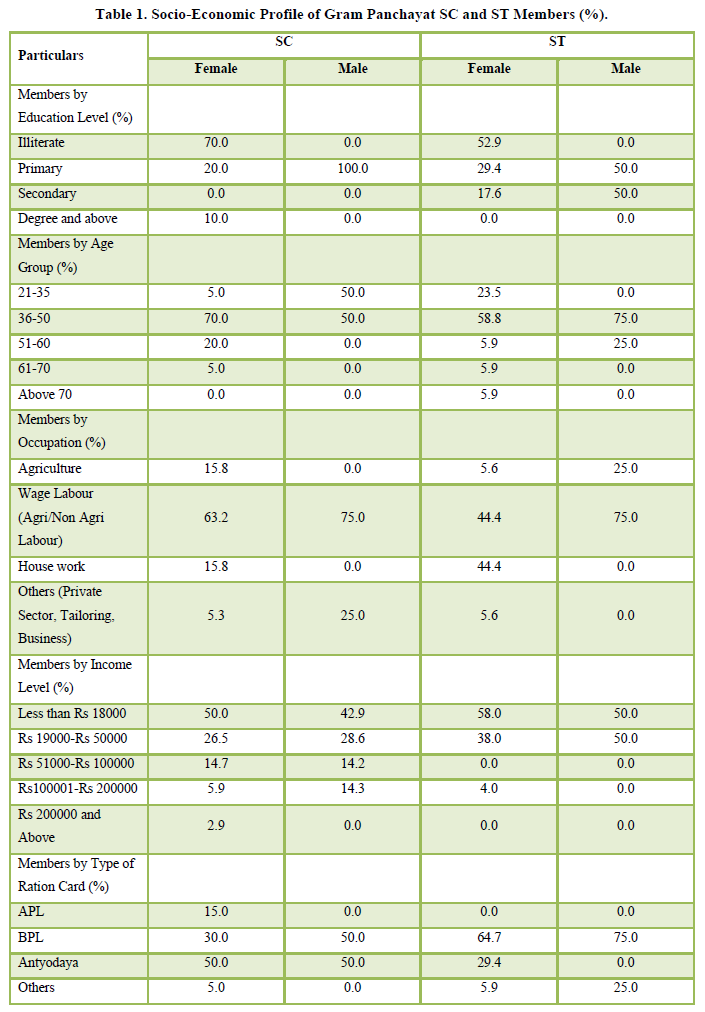
This has helped these members to enter into politics and contest panchayat elections. However, majority of the members were first entrants to Gram Panchayat elections. Reservation of seats has enabled them to contest for the elections. Now, members belonging to weaker sections, including women, are contesting in the wards where the seats are allotted for general category. This shows increased level of confidence among the weaker sections, particularly women. Table 2 shows proportion of SC/ST members across the different categories of seats.
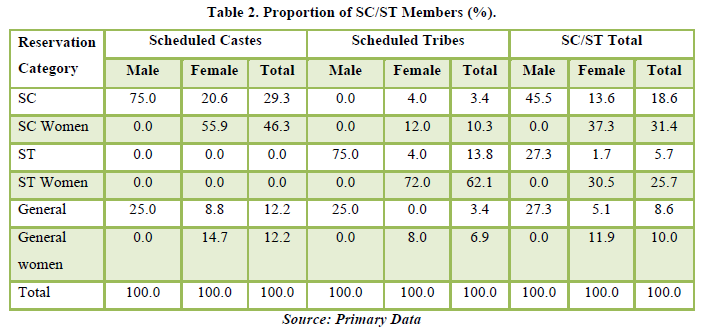
Motivation for Contesting GP Election
Table 3 shows sources of motivation for contesting Gram Panchayat election. It depicts that motivations for contesting for GP member are varied especially for male and female members. Apart from self-motivation, male members are motivated from the ward people. Whereas in case of female the proportion of members self-motivated is less compared to male, irrespective of caste. These members are mainly motivated from the family members, ward and caste people to contest the elections. On the whole, male members are mainly self-motivated and supported by ward people. In case of female, motivation of family is important and is supported by ward people. The discussion with the women members reveals that in recent years, more and more women are coming forward to contest the elections on their own. This indicates that women belonging to weaker sections are now getting ready to face the challenges which they were facing traditionally.
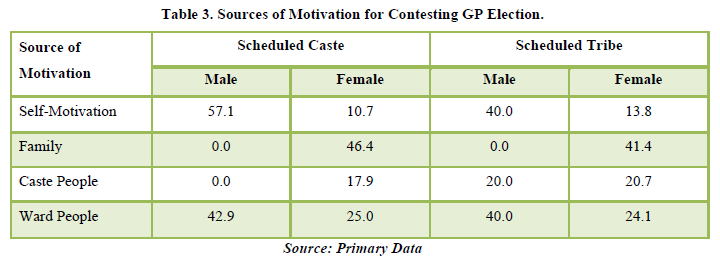
Participation in Local Organization
Apart from the Panchayat activities, SC/ST Members have also been participating in different local organizations such as Self-Help Groups (SHG), School Development Management Committee (SDMC), Village Water Supply and Sanitation Committee (VWSC) and caste associations (SC/ST). Proportion of participation of male and female members is almost the same i.e. 75 Per cent. Table 4 indicates that female members mainly participated in Self Help Groups (SHG) activities whereas male members participated in School Development Management Committee (SDMC) and caste associations. The participation of male members in local organization is more than the participation of female members. On an average male participated in 3 organizations and female participate in 2 organizations (Table 4).
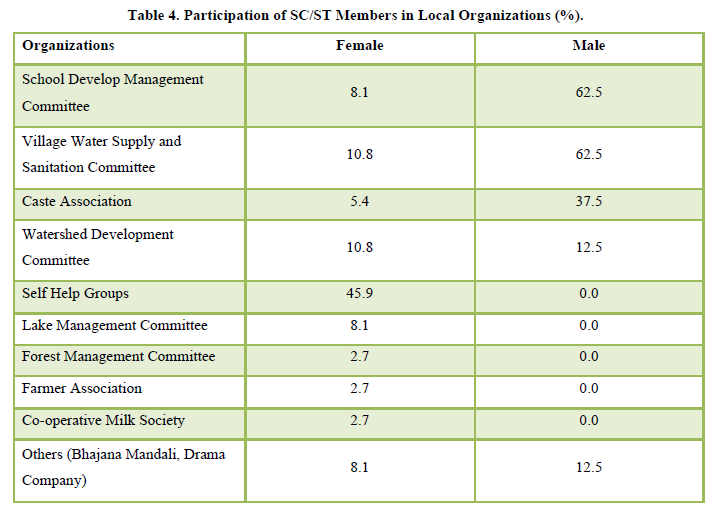
Decision Making Power
It is expected that all the GP members should take independent decision in GP activities without getting any influence from other people. Graph 1 shows proportion of members who take independent decision in the activities of Gram Panchayats. It reveals that male members, either SC or ST take independent decision. The proportion of female members who take independent decision is less compared to male members. Female members get the help/advise mainly from family members, especially from their husband. Among the female, ST female members performing better as compared to SC female members in taking independent decision. It can be observed in some of the GP that female members hesitate to come alone to Panchayat to attend the meetings. They are accompanied with the family members as the traditional concept of patriarchy still exists in rural area. Discussion with the members reveals that this type of notion has been declining gradually in the rural areas and more and more female members coming along to GP. This is the good sign of empowerment of women.
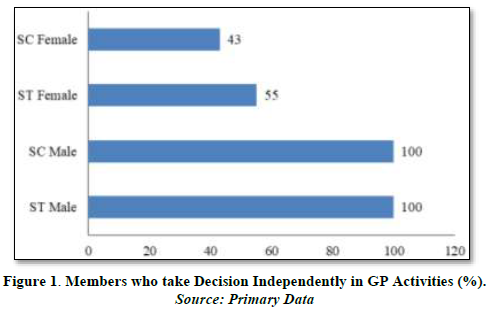
Willingness to Contest Election in Future for PRIs
Usually panchayat members, who were elected for the first time to Gram Panchayat, took it as an opportunity to understand about function of GP, various developmental schemes and to acquire the necessary skills of the self-governance. Most of the SC/ST members contested election without political background and many of them were elected due to family and pressure from village leaders or political leaders. The willingness to contest election in future for PRIs shows interest and confidence in the political field. Graph 2 presents willingness of the SC/ST representatives of GP to contest in future election to serve the people. It shows that majority of the members are willing to contest the elections in future. Majority of the SC/ST female members who contested panchayat election due to the pressure from family and village leaders showed willingness to contest in future panchayat elections as they gained knowledge, experience and interest in politics as members of GP.
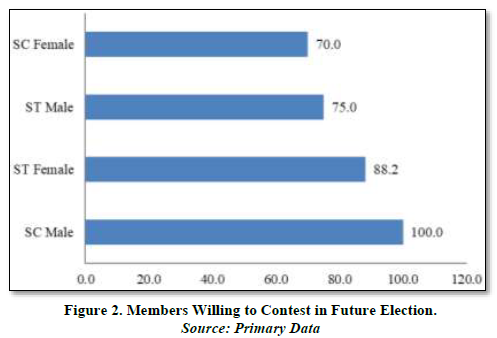
CAPACITY BUILDING PROGRAMME AND EMPOWERMENT
Capacity Building of Members through Training
In Karnataka, the State Training Institute (SIRD), Mysore regularly conducts satellite training programme for Panchayat representatives. Apart from this some NGOs and private institutes also organize training programme to help representatives become more self-confident and to give them more knowledge about their role and responsibility as Grama Panchayat members. Graph 3 shows proportion of SC/ST members who attended training programmes earlier conducted by State Training Institute, Mysore, at taluk or district level. It reveals that all the male members participated in training programmes and whereas the participation of female is less. Moreover, it has been also observed from the discussion with the members that female members attended a smaller number of trainings. On an average, participation of male and female are 8 and 6 respectively.
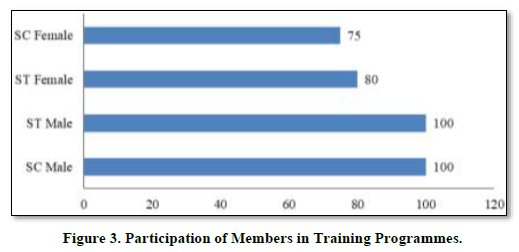
Discussion with the members reveals that following are the main reasons for not attending the trainings (regularly). They are:
- Lack of co-operation and communication gap between PDO and members
- Lack of earlier intimation by Taluk Panchayat and Grama Panchayat
- No proper transport facility/arrangement
- Dominance of upper caste male members in training
- Female members have family responsibilities, i.e. taking care of their children at home
- Most of them are agricultural laborers and they cannot forego their daily earnings
Perception about Special Capacity Building Programme
CMDR had organized 3-day training programme for SC and ST Gram Panchayat members of Hubballi taluk in Karnataka during the year 2015. Hubballi is one of the relatively developed taluks in Karnataka according to High Power Committee Report (2002). There are 53 SC/ST members in the taluk out of total 323 members. The training programme was organized well in advance with earlier intimation to the GP members. Officers from CMDR visited the members’ house to induce them to attend the programme and they also sought the co-operation of the family members to send the GP member (especially female members) to training. Taluk Panchayat and Gram Panchayats were also extended the support. Members have been provided with travel facility and daily allowance. Thus, all efforts were made to avoid the limitations of the earlier training programmes. Members opined that capacity building programme for SC/ST women members is a good way of breaking of caste; exchange their knowledge and better opportunity to help each other. Women SC/ST members felt that it would help them if separate training programmes are organized for women. They said that men do not encourage them to ask questions and laugh when women ask questions during the training programme.
Case 1: Empowerment through Capacity Building Programme
A ST women member of Adargunchi Grama Panchayat, got elected for the first time in Grama Panchayat election According to her, she contested election with self-interest. After receiving 2 times training programme she realized about her role and responsibility at panchayat level. She felt that training programme provided her more self-confidence, more knowledge, awareness about her role, rights, responsibility in panchayat as well development and welfare programmes. This knowledge helps to her attend a women empowerment workshop at Jaipur Rajasthan. She felt that after getting 4 times training she became more independent and as a panchayat member she is actively participating in panchayat activities and is attending to several problems related to drinking water, roads, housing and school. She told that she has a dream to contest TP or ZP election and continue in the political line. Finally, because of capacity building programme she become active in panchayat activities and occupied a respectable position in the society.
Overall, the members felt that the training programme meant for SC/ST members, conducted by CMDR, has increased their self-confidence, knowledge and led to overall improvement in personality. Now, they can ask for the rights of weaker sections and get the problems solved. It has been observed during the training programme that the female representatives are still hesitant to respond to questions in front of male members. The female members informed that men do not encourage them to ask questions and they laugh at them when women members ask questions. Therefore, women members felt separate training programme for women. They wish that training programmes should focus on i) women empowerment, ii) programmes for SCs /STs and, iii) legal issues and application of various laws. On the nature of training programmes they said that the programmes should be participatory, include humor, jokes, discussions and not just narrating about the panchayat acts, functions, programmes, etc. In addition, they added that this type of capacity building programme should be conducted within 6 months after the Grama Panchayat election for women members separately. This type of special programme would help SC/ST women representatives for effective implementation of scheme/programme and carry out development work in the panchayat level.
CONCLUDING OBSERVATIONS AND POLICY IMPLICATIONS
The paper finds that almost all the SC/ST female members have poor social and economic background. Reservation of seats of GP has given them the opportunity to contest the elections and enter in to Gram Panchayats. Now SC/ST female members are contesting not only for reserved seats but also for other seats (general category). After being elected, most of the female members get training to have knowledge about GP activities. But the proportion of attending the training programme is less compared to male members. The level of empowerment of female members reveals that they are lagging behind in terms of taking independent decision, attending training programmes, participation in local organizations and willingness to contest elections in future. The members found that special training for SC/ST members has helped to increase the self-confidence, knowledge and awareness about their role, rights and responsibilities. SC/ST female members felt that special training only for SC/ST female members would be more beneficial apart from general training programmes.
- Chauhan, A. (2003). Women Participation in Panchayats in Scheduled Areas with Special reference to Madhya Pradesh presented paper in a workshop on “A Decade of Women’s Empowerment through Local Government in India” Sponsored by Institute of Social Science, and South Asia Partnership Canada.
- Dahlerup, Drude. (2005). “Giving Voice to the Voiceless: A field study from India about capacity building towards women in Panchayats as an Instrument for Empowerment”, Published by Statsvetenskaplig Institution, Stockholms University.
- Decentralization Analysis Cell (2009). Tribal Population in Gram Swaraj Project Area Their inclusion and fiscal devolution in Panchayat Raj Institution an empirical study, Rural Development and Panchayati Raj Department Government of Karnataka Bangalore.
- Infochange Women (2013). 50% quota for women in all tiers of Panchayati raj published on 17th May 2013. Available online at: http://infochangeindia.org/women/news/50-quota-for-women-in-all-tiers-of-panchayati-raj.html accessed on 20/5/2013
- Jayasimha., K, Kumar & Kiran, R. (2000). The anatomy of Gram Panchayats A study of Dharwad district TIDE Development Research Foundation Bangalore.
- Mishra S.N, Lokesh Kumar., & Pal, C. (1996). New Panchayat Raj in Action. Published by Mittal Publications New Delhi.
- Palanithurai G (2003). Elected Women Representatives and Emerging Alternative Governance Rajiv Gandhi Chair for Panchayat Raj Studies Gandhigram Rural Institute Gandhigram, Tamil Nadu.
- Palanithurai G (2005). Good Governance at Grassroots Rajiv Gandhi Chair for Panchayat Raj Studies Gandhigram Rural Institute Gandhigram, Tamil Nadu.
- Palanithurai G & Vani Shree (2004). Governance from the Perspective of Elected Women Representatives (EWRs) Rajiv Gandhi Chair for Panchayat Raj Studies Gandhigram Rural Institute Gandhigram Tamil Nadu.
- Sachchidananda (2006). Empowerment of Elected Members through PRIs in Bihar Sponsored by Planning Commission, Government of India New Delhi.
- Sivanna N. (2014). Politics of Exclusion the Case of Scheduled Castes in the Panchayats of Karnataka Social Change 44, 39-66.
- Tame Ramya (2014). Political Representation of Tribal Women in Arunachal Pradesh The Case of 2013 Panchayat Raj Election in Kurung Kumey District. Journal of Intellectual Collective India, 2, 97-107.




